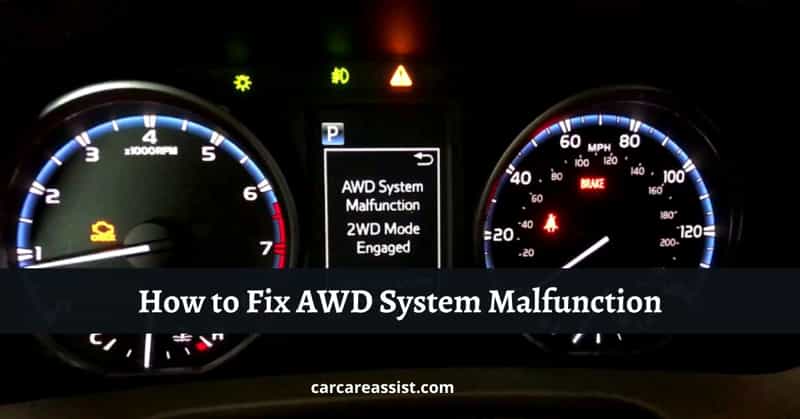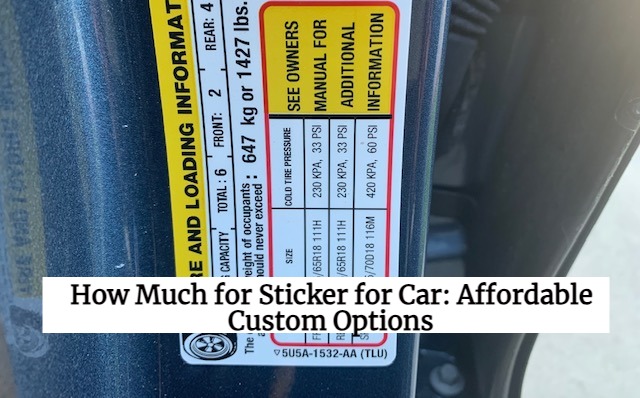How to Fix AWD System Malfunction
One of the most important features on an all-wheel drive car is the ability to transfer power to all four wheels. When this system malfunctions, it can be a huge inconvenience. In this article, I will discuss what to do if you experience an AWD system malfunction while driving. And how to fix AWD system malfunction.
So, without further ado, let’s get started!
What does AWD system malfunction mean?
An AWD system is a four-wheel drive system that distributes power evenly to all four wheels of a vehicle. This helps with traction and stability, making it an essential feature—especially in inclement weather conditions.
There are two types of AWD systems: active and passive. Active systems have sensors that monitor traction and wheel slip. When they detect that one or more wheels are losing traction, they send power to those wheels to help them regain grip. Passive systems, on the other hand, do not have sensors. Instead, they rely on the driver to manually select the appropriate mode for the conditions.
Most modern cars are equipped with active systems, which are more effective and provide a better driving experience.
What causes an AWD system to malfunction?
A few different things can cause an AWD system to malfunction. One of the most common reasons is a loss of power to the system. A blown fuse, disconnected battery, or loose wiring can cause this. Another common cause is a problem with the front or rear differential. A leak, damaged gears, or a worn-out bearing can cause this. Lastly, an AWD system may malfunction if there is an issue with the transfer case. This could be due to a broken chain or a faulty sensor.
How to identify an AWD system malfunction?
If you’re unsure whether your AWD system is malfunctioning, there are a few signs to look out for. One of the most common symptoms is a loss of power to the system. A blown fuse, disconnected battery, or loose wiring can indicate this.
Another symptom of a system issue is a problem with the front or rear differential. A leak, damaged gears, or a worn-out bearing can cause this. Lastly, an AWD system may malfunction if there is an issue with the transfer case. A broken chain or a faulty sensor could indicate this.
If you notice any of these symptoms, you’ve to take immediate action and fix the problem.
How to Fix AWD System Malfunction
You can do several things to fix an AWD system malfunction. One of the first is to check the fuse box and make sure all of the fuses are intact. If one of the fuses is blown, replace it with a new one.
Next, check the battery and make sure it is properly connected. If the battery is disconnected, reconnect it and make sure the connections are tight. If the battery is low on power, charge it or replace it with a new one. If the battery is fine, then check the wiring to see if there are any loose connections.
If those steps don’t fix the problem, you should check it next with the front or rear differential. If there is a leak, tighten the differential’s seals. If the gears are damaged, replace them with new ones. And if the bearings are worn out, replace them as well.
However, if the issue is with the transfer case, you can try a few things. First, check the fluid level and make sure it is full. If it is low, then add more until it reaches the correct level.
Next, check the chain to see if it is broken or damaged. If it is, it will need to be replaced.
Finally, check the sensor to see if it is working properly. If it is not, then you will need to replace it.
Following these steps should help you fix an AWD system malfunction. If you are still having issues, it is best to take your car to a mechanic for a checkup.
Things you can do to prevent an AWD system malfunction from happening in the first place
You can do a few things to prevent an AWD system from malfunctioning. One of the best is keeping the system clean and free of dirt and debris. This will help ensure that all of the parts can move freely and without obstruction.
Another thing you can do is regularly check all of the system’s parts to ensure they are in good working condition. This includes checking the fuses, battery, wiring, and differential. If you notice any problems, you can take care of them before they cause a larger issue.
Lastly, you can ensure that there is always enough fluid in the system. This will help keep all of the parts properly lubricated and prevent premature wear.
By following these tips, you can help prevent an AWD system malfunction. However, if one does occur, you will know how to fix it.
FAQs about AWD system malfunctions
Q: What are some common symptoms of an AWD system malfunction?
A: The most common symptoms of a system issue are a loss of power, a problem with the front or rear differential, or an issue with the transfer case.
Q: How often should I check the fluid level in my AWD system?
A: You should check the fluid level in your AWD system at least once a month. This will help ensure that all of the parts are properly lubricated and prevent premature wear.
Q: What should I do if I notice a problem with my AWD system?
A: If you notice a problem with your AWD system, try to follow the steps I’ve mentioned. The best thing to do is take it to a mechanic to have it checked out. They can diagnose the issue and recommend the best course of action.
Q: Can I prevent an AWD system malfunction from happening?
A: yes, you can prevent an AWD system malfunction from happening by taking some precautionary measures. This includes keeping the system clean, regularly checking all parts, and ensuring you always have enough fluid in the system.
Q: What will happen if I ignore a problem with my AWD system?
A: If you ignore a problem with your AWD system, it could further damage the system. This could eventually result in a complete breakdown of the system. Therefore, taking care of any issues as soon as you notice them is best.
Q: My car is still under warranty. Will my dealership cover the cost of repairs?
A: It depends on the dealership and the terms of your warranty. You will need to check with your dealership to see if they will cover the cost of repairs for an AWD system malfunction.
Q: What is the average cost of repairs for an AWD system?
A: The average cost of repairs for an issue with the system is around $500. However, this will vary depending on the issue’s severity and your car’s make and model.
Q: Can I do the repairs myself?
A: A qualified mechanic can perform many of the repairs for an AWD system. However, some of the more complex repairs may require a certified technician. Therefore, it is best to check with your mechanic to see if they can do the repairs before attempting them yourself.
Conclusion
By following the tips in this article, you can help to prevent an AWD system malfunction from happening. However, if one does occur, then you know how to fix it. If you notice any problems with your system, take care of them as soon as possible to avoid further damage.







